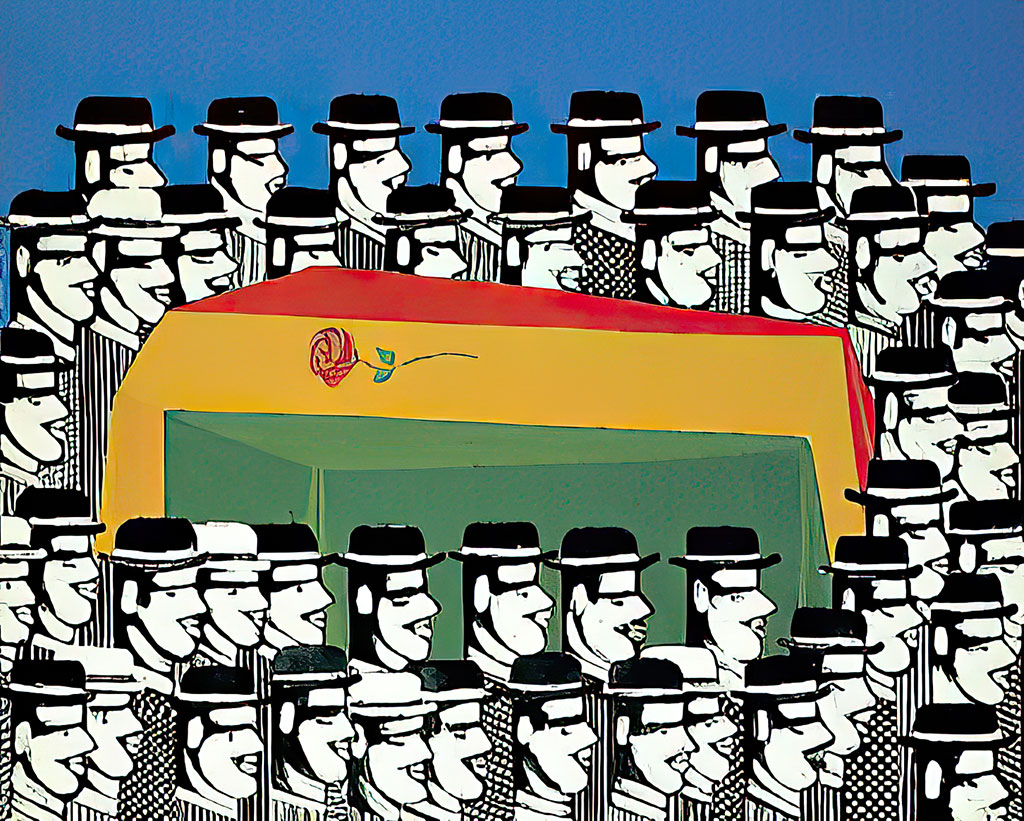ART-TRIBUTE:Yannis Gaitis-The Crowd and the Loneliness,Part I
 Yannis Gaitis is best known for his paintings of repeating men dressed identically in hats and plaid jackets. Throughout his oeuvre, the figures in his works represent the men of the modern society: alone, homogeneous, interchangeable. This alienation was the sole focus of his artistic career, culminating in singularly concentrated body of work.
Yannis Gaitis is best known for his paintings of repeating men dressed identically in hats and plaid jackets. Throughout his oeuvre, the figures in his works represent the men of the modern society: alone, homogeneous, interchangeable. This alienation was the sole focus of his artistic career, culminating in singularly concentrated body of work.
By Dimitris Lempesis
Photo: GI Katsigras Museum Archive
A big exhibition entitled “The Crowd and the Loneliness” dedicated Giannis Gaitis’ work is on presentation in The Municipal Gallery of Larissa – GI Katsigras Museum. The exhibition records the course of Giannis Gaitis from the mid-1940s to the early 1980s, from his first paintings, with obvious influences from Pablo Picasso and the art of the surrealists to his quests in abstraction. And from his narrative microcosms to his anonymous and uniform little people, with the striped and plaid costumes, the little people with whom he identifies and asks us to identify. The well known human forms of Gaitis with their typical hats, their stripped or plaid suits, their monochrome neckties and the austere range of contrary colors come through his engravings to express his functionalistic world with the intensive social criticism and the bitter taste of life through the lack of individuality. Giannis Gaitis studied at the Athens School of Fine Arts and in 1949 participated, with Alekos Kontopoulos and other artists who had turned to abstract art, in the founding of the group “The Extremists”. In 1954 he went to Paris where he completed his studies at the School of Fine Arts and the Grande Chaumiere Academy. In 1959, in Rome, he became a member of the Gruppo Sigma group, together with Nikos Kessanlis, Vlassis Kaniaris, Dimitris Kontos and Kostas Tsoklis. Working both in Paris and Athens and having started his exhibition activity in 1944 with a solo show at his studio and then at the Parnassos Hall, he continued to present his work at solo shows in Parisian and Athenian galleries as well as European countries and America while in 1984, a week before his death, a large retrospective was launched at the National Gallery. His early characteristic creations include the well-known Landscapes of Hydra Island, which move mainly to the extensions of cubism and have obvious symbolic tendencies. In later versions, the natural space is transformed into a series of geometric units, which are distinguished for their color nobility, formal purity, structural elements and abstract characteristics. In the period 1960-1967 the painting surface of his works is divided into smaller sections, with rudimentary forms, which aim at rendering a semantic language with parallel symbolic extensions. The people-insects, the paintings inside the painting, the use of cartoon elements and realistic references and their combinations with abstract and imaginative themes give extremely expressive results. Just past the midpoint of the Sixties he began to make his wellknown figure of a little man, which he originally repeated around a central representation and later made into a schematic and standardized figure, constituting a symbol and ironic means of social criticism, repeated in a number of variations. Since 1975, the stylized forms multiplied and consolidated, resulting in the creation of human landscapes. The grouped world, the mechanized society, the absolute imposition of quantity on quality become a mirror of the time. He died in 1984 in Athens, a week after the opening of his major exhibition at the Athens National Art Gallery.
Info: Curator: Loretta Gaitis and Yannis Bolis, Larissa Municipal Gallery-G.I. Katsigra Museum, 2 G. Papandreou str, Larissa, Duration: 10/8/20-spring 2021, Days & Hours: Tue-Sun 10:00-14:00 & 18:00-21:00, www.katsigrasmuseum.gr

Center: Yannis Gaitis, The strange things of the world C’, oil on wood, 198×78 cm.,
Collection Tryfonas Gaitis Collection-Athens, Greece
Right: Yannis Gaitis, Construction made of painted wood and metal, 189×46,5×46,5 cm, Private Collection Greece


Right: Yannis Gaitis, The mannequin, oil on canvas, 146×114 cm, Private collection, Greece

Right: Yannis Gaitis, The Stripper, 1967, oil on canvas, 130×97 cm, Private Collection, Greece


Right: Yannis Gaitis, Banner, fabric, 200x98cm, Private collection, Greece


Right: Yannis Gaitis, Geometric A, oil on canvas mounted on hardboard, 159.5×106 cm, Private Collection, Greece


